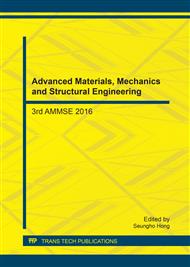[1]
E. Cross, Lead-free at last, Nature, 432 (2004) 24.
Google Scholar
[2]
R. A. Eichel, H. Kungl, Recent developments and future perspectives of lead-free ferroelectrics, Funct. Mater. Lett. 3 (2010) 1.
DOI: 10.1142/s179360471000097x
Google Scholar
[3]
D. Damjanovic, N. Klein, L. Jin, V. Porokhonskyy, What can be expected from lead-free piezoelectic materials, Funct. Mater. Lett. 3 (2010) 5.
DOI: 10.1142/s1793604710000919
Google Scholar
[4]
G. A. Smolensky, V. A. Isupov, A. I. Agranovskaya, N. N. Ktainik, New ferroelectrics of complex composition. IV, Sov. Phy. Solid State 2 (1961) 2651.
Google Scholar
[5]
T. Takenaka, K.I. Maruyama, K. Sakata, Thermodynamic properties and phase equilibria of the potassium-indium system by electromotive force measurements, Jpn. J. Appl. Phys. 30 (1991)2236.
DOI: 10.1088/0953-8984/3/11/018
Google Scholar
[6]
J. Rödel, W. Jo, K. T. P. Seifert, E. M. Anton, T. Granzow, D. Damjanovic, Perspective on the Development of Lead-free Piezoceramics, J. Am. Ceram. Soc. 92(6) (2009) 1153-1177.
DOI: 10.1111/j.1551-2916.2009.03061.x
Google Scholar
[7]
K. Uchino, Piezoelectric Actuators and Ultrasonic Motors (Kluwer Academic, AH Dordrecht, The Netherlands, 1997).
Google Scholar
[8]
G. H. Haertling, Ferroelectric Ceramics: History and Technology, J. Am. Ceram. Soc. 82(4)(1999) 797-818.
Google Scholar
[9]
D. Berlincourt, Piezoelectric and Piezomagnetic Materials and Their Function in Transducers, J. Acoust. Soc. Am. 91 (1992) 3034-3040.
Google Scholar
[10]
A. Albareda, R. Pérez, J. E. García, D. A. Ochoa, V. Gomis, J. A. Eiras, Non-linear dielectric and piezoelectric response in undoped and Nb5+ or Fe3+ doped PZT ceramic system, J. Eur. Ceram. Soc. 27(13-15) (2007) 4025.
DOI: 10.1016/j.jeurceramsoc.2007.02.086
Google Scholar
[11]
T. M. Kamel, G. D. With, Poling of hard ferroelectric PZT ceramics, J. Eur. Ceram. Soc. 28(9) (2008) 1827.
Google Scholar
[12]
M. Morozov, D. Damjanovic, N. Setter, The nonlinearity and subswitching hysteresis in hard and soft PZT, J. Eur. Ceram. Soc. 25(12) (2005) 2483.
DOI: 10.1016/j.jeurceramsoc.2005.03.086
Google Scholar
[13]
M. I. Morozov, D. Damjanovic, Hardening-softening transition in Fe-dopedPb(Zr, Ti)O3ceramics and evolution of the third harmonic of the polarization response, J. Appl. Phys. (2008), 104: 034107-034107-8.
DOI: 10.1063/1.2963704
Google Scholar
[14]
Y. Hiruma, H. Nagata, T. Takenaka, Thermal depoling process and piezoelectric properties of bismuth sodium titanate ceramics, J. Appl. Phys. 105 (2009) 084112.
DOI: 10.1063/1.3115409
Google Scholar
[15]
M. Zhu, H. Hu, N. Lei, Y. Hou, H. Yan, Dependence of depolarization temperature on cation vacancies and lattice distortion for lead free 74(Bi1/2Na1/2)TiO3–20. 8 (Bi1/2K1/2) TiO3–5. 2BaTiO3ferroelectric ceramics, Appl. Phys. Lett. 94 (2009).
DOI: 10.1063/1.3130736
Google Scholar
[16]
Y. L. Huang, Y.C. Lee, D. C. Tsai, J. D. Chiu, F. S. Shieu, Effects of manganese oxide addition and reductive atmosphere annealing on the phase stability and microstructure of yttria stabilized zirconia, J. Eur. Ceram. Soc. 33(13-14) (2013) 2609.
DOI: 10.1016/j.jeurceramsoc.2013.04.004
Google Scholar
[17]
H. Kaftelen, M. Tuncer,S. Tu, S. Repp,H. Göçmez,R. Thomann,S. Weber,E. Erdem, Mn-substituted spinel Li4Ti5O12 materials studied by multifrequency EPR spectroscopy, J. Mater. Chem. A, 1 (2013) 9973.
DOI: 10.1039/c3ta11590a
Google Scholar
[18]
M. K. Zhu, L. Y. Liu, Y. D. Hou, H. Wang, H. Yan, Microstructure and electrical properties of MnO-doped (Na0. 5Bi0. 5)0. 92Ba0. 08TiO3 lead-free piezoceramics, J. Am. Ceram. Soc. 90(1) (2007) 120.
Google Scholar
[19]
Y.C. Guo, H.Q. Fan, C.B. Long, J. Shi, S.H. Lei, Electromechanical and electrical properties of Bi0. 5Na0. 5Ti1-xMnxO3-d ceramics with high remnant polarization, J. Alloys compd. 610 (2014) 189-195.
DOI: 10.1016/j.jallcom.2014.04.038
Google Scholar
[20]
Q. Chen, Z.H. Peng, H. Liu, D.Q. Xiao, J.L. Zhu, J.G. Zhu, The crystalline structure and phase-transitional behavior of (Li0. 12Na0. 88)(Nb1-xSbx)O3 lead-free piezoelectric ceramics with high Qm, J. Am. Ceram. Soc. 93(9)(2010) 2788-2794.
DOI: 10.1111/j.1551-2916.2010.03813.x
Google Scholar
[21]
I. Burn, Mn-doped polycrastalline BaTiO3, J. Mater. Sci. 14(10) (1979) 2453-2458.
DOI: 10.1007/bf00737036
Google Scholar


